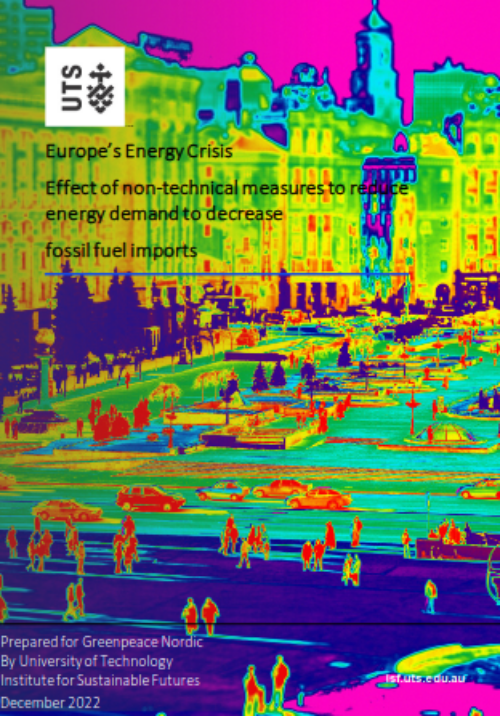EU Crisis Scenario
Prepared for Greenpeace Nordic.
Institute for Sustainable Futures.
The European Union (EU-27) had a massive reliance on Russian fossil-fuel energy sources (fossil gas, oil and coal). After the Russian invasion of Ukraine and following political tensions, the EU responded with a string of political measures. This led to Russia using partial & total cut-offs of fossil gas as a blackmail method. In the “Save gas for a safe winter’ the EU came with suggestions for how to solve shortages of Russian gas by maximum filling of the gas storage facilities, a voluntary gas demand reduction target of 15% for member states by this winter and increasing the share of renewables as quickly as possible. As of November 2022, the EU member states have more or less full gas storage facilities, an average fossil gas demand reduction has been achieved of 7.4% up to August and the European weather has been mild. However, in 2023 the EU-27 will face a similar crisis as in 2022 without the potential to fill the gas storage facilities with Russian gas. This crisis scenario identifies short-term non-technical measures focused on demand reduction to react to fossil fuel supply shortages caused by the invasion of Ukraine by Russia. IEA’s analysis signals the need for at least 30 bcm demand reduction in 2023.
In this report we investigated the main research question: “What is the effect of non-technical measures on the EU-27’s fossil gas/oil/total energy demand?” Here, non-technical measures require no new investment in equipment (the timespan of the crisis is simply too short for an immediateIt overhaul of the entire energy system).
This question is analysed with the 1.5 °C energy transition pathway modelled by the One Earth Climate Model. The One Earth Climate Model is the in-house granular sector model of the Institute of Sustainable Futures, which performs detailed bottom-up examination of energy demand and supply from now up to 2050. The base energy transition scenario for the EU-27 contains a rapid uptake of renewable energy sources and no new investments in fossil-fuel energy sources.
The effect of two different scenarios (high industry share vs. medium industry share) for demand reduction were expressed in demand for fossil gas, oil and total energy:
• Different stacking of demand reduction measures could achieve roughly the same savings. This gives the active choice to shift measures between the industrial sector and the other sectors. We also need significant savings of fossil gas consumption used for power generation which has increased the last few months of 2022.
• Fossil gas: Industrial and residential heat savings have the largest potential for achieving fossil gas reductions.
• Oil: less driving & efficient driving leads to the largest reductions compared to the other measures.
To fill the gap left by the share of Russian imported energy, it is crucial to reduce energy demand and increase sustainable renewable energy in the industry, heating and transport sectors. To achieve heat and transport decarbonization, sustainable renewable heat must increase, transport should be electrified, and a sharp increase of onshore & offshore wind and solar energy generation is required.
In addition, a quick ramp-up of renewable energy generation is required to replace electricity generation with renewable sources instead of falling back into old fossil-fuel habits. Solar (roof-top and utility) and wind (onshore &
offshore) must become the default in the European energy system.
